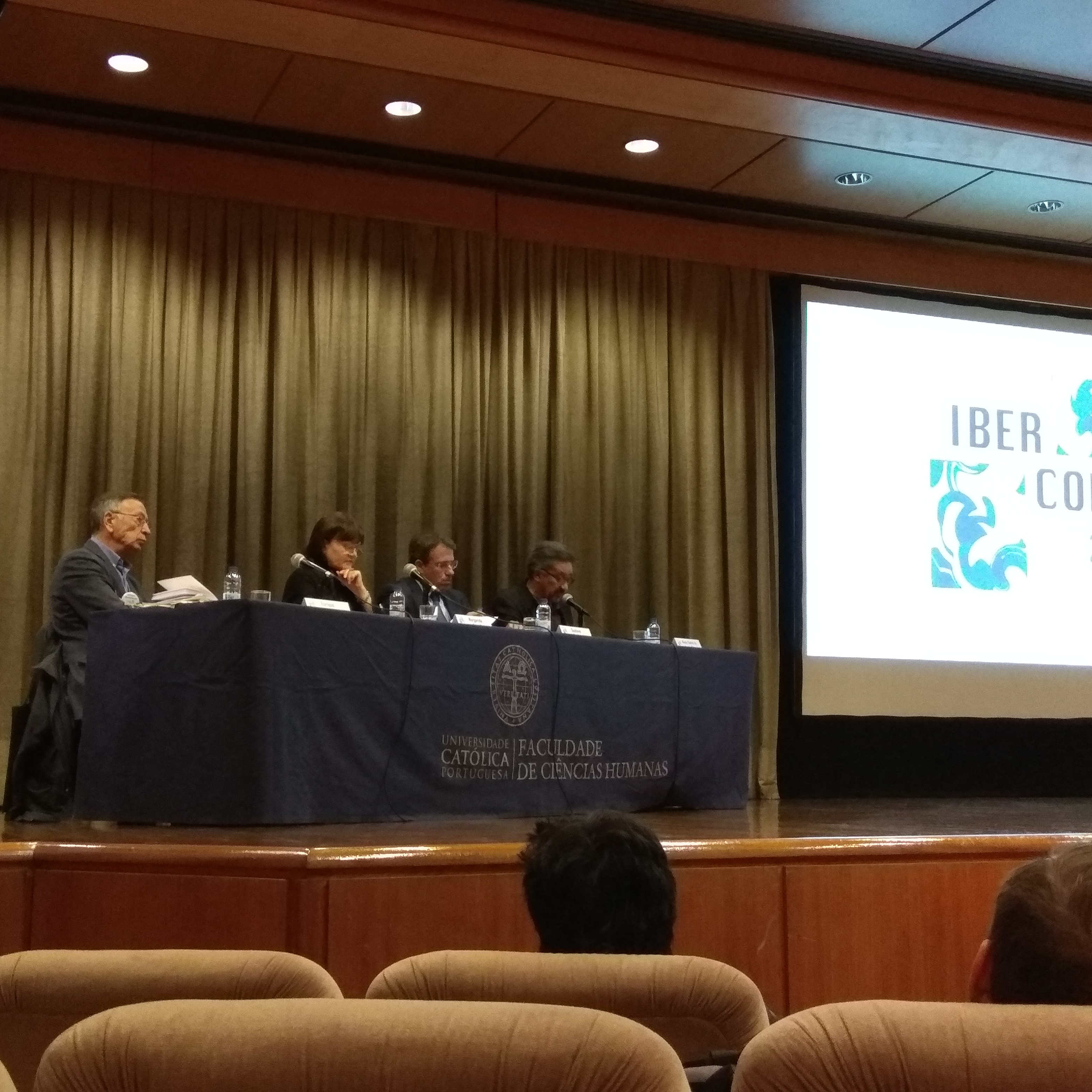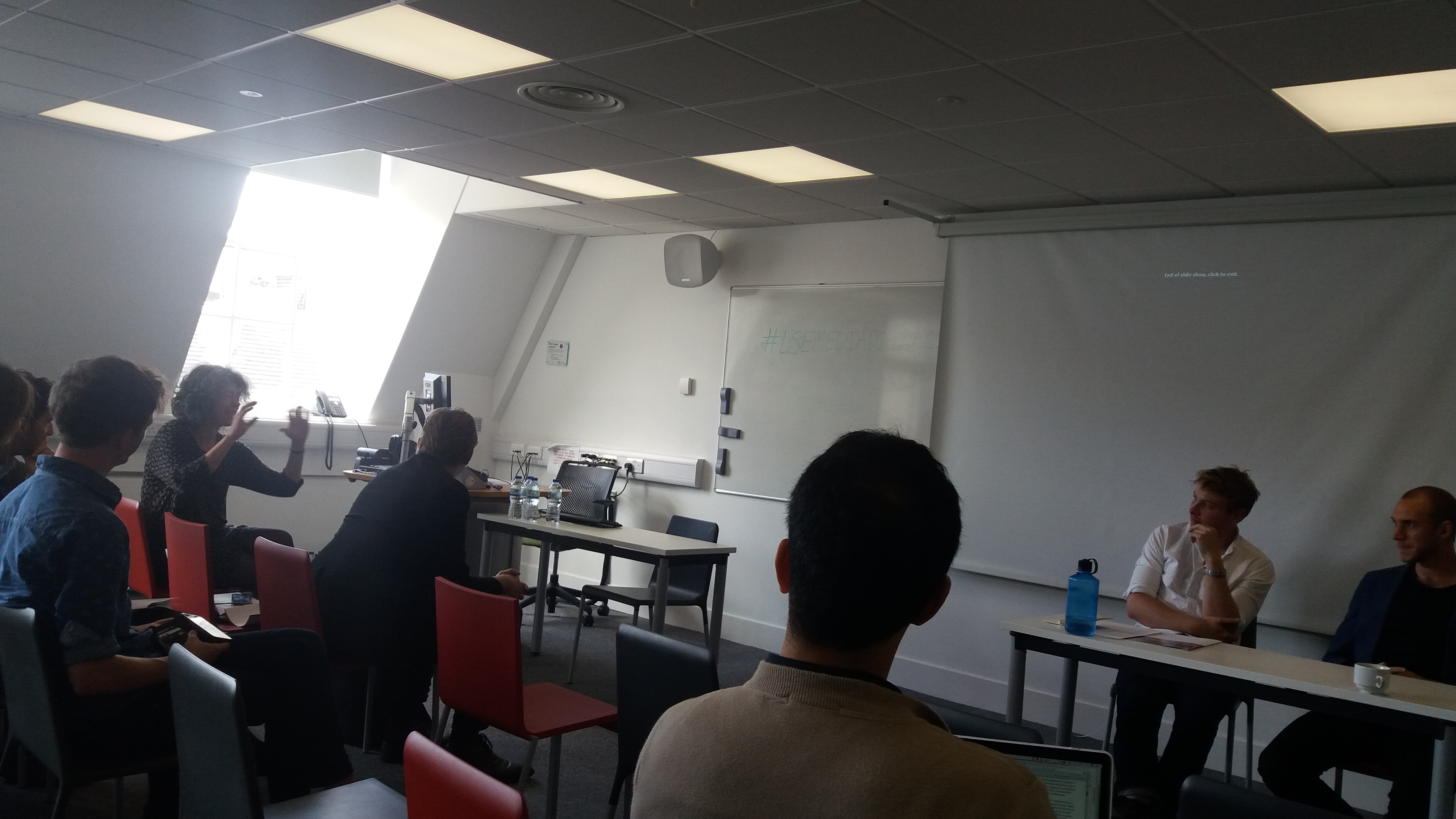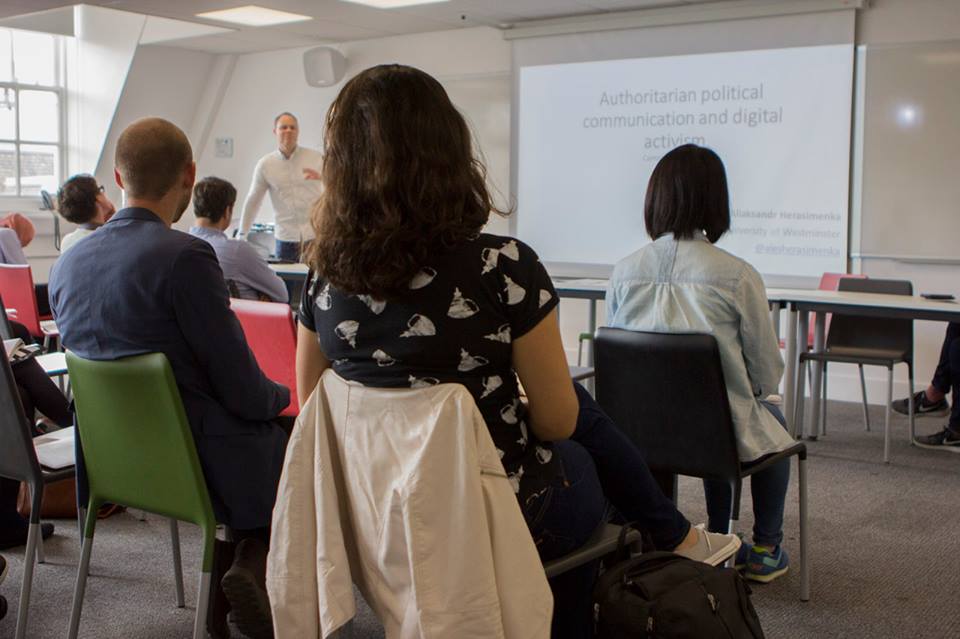Trago o texto que guiou minha apresentação no Congresso da ICA (International Communication Association), que aconteceu em Washington D.C., no final do mês de maio de 2019, onde tive a chance de participar de um painel sobre jornalismo e ativismo com a participação dos pesquisadores Adrianne Russell (que presidiu a mesa), Gino Canella e Urszula Pruchniewska.
My presentation is about the articulations between the standards of traditional journalism and the political engagement which characterizes many alternative media projects, what dialogues directly with Adrianne Russell’s book, Journalism as Activism (2016). But my focus is a little different: I am interested in the meanings produced by this kind of hybrid content, mainly in audio-visual productions, to grasp what prevails and to identify changes in the journalistic practices, and eventually in the journalistic field.
The journalism was structured as a professional organization at the beginning of the twentieth century (Schudson, 1982, 2001), guided by specific rules and values that allow us to identify the journalistic practice and its discourse, establishing an ideology (Deuze, 2005). The journalistic objectivity is the basis of its hegemonic model, which is supported by the separation between information and opinion, the search for impartiality and balance, as well as the emphasis on the truth as the main goal to be reported. However, what is the truth? Since the 70s, many authors started to criticize this model, as Stuart Hall (1978), who argued that objectivity functions as a discursive strategy to maintain the status quo, by reproducing the structures of power, which happens, for example, by disguising the biases and privileges that are implicit in the rules which form the news values (Galtung & Ruge, 1965; Harcup & O’Neill, 2001).
Studies based on critical discourse analysis reinforced the critics, by demonstrating the impossibility of building a neutral discourse (Charaudeau, 2006; van Dijk, 2005). On the contrary, every discourse is a social practice immersed in the disputes and tensions that mark the social life, and because of that, every text or speech have different marks of beliefs, values, cultures, and ideologies that define biases. Rather than avoid adjectives or adverbs, keeping a descriptive approach, the journalistic discourse takes positions when determining, for example, what is the most important, what is less important, who should be heard, and who should not, which space certain information deserves, etc.
Even under these critics, the standards of journalistic objectivity remain the most recurrent in the mainstream media. It continues related to the “good” journalism, the “professional” journalism (Carpentier & Trioen, 2010), in opposition to the “amateur”, or the low-quality journalism. Such negative features are often associated with alternative media publications.
On the other hand, with all the social transformations produced by the deep mediatization (Couldry & Hepp, 2017), we have also seen changes in media consumption, which have reached the news and interfered in their production. Among the consequences, there is the multiplication of new actors who produce and distribute journalistic messages, which makes the field increasingly segmented and fragmented and favors hybridities.
When we talk about hybridity, we talk about the intersection between fields, which can change practices and create new meanings. In the journalistic field, one of these possible hybridities is that one between the journalism, and its values and roles, and the political engagement, as Adrienne Russell showed in her book, including in the mainstream media. This approach results in new practices and new priorities that aim to guide news productions, which is no longer handled exclusively by business issues, but by a wish for social justice, for example.
These hybridities have different intensities, sometimes leaning more towards the journalistic values and norms, and in other moments towards activist’s values and practices. In this work, I choose two media projects that integrate my Ph.D. research, to discuss how they articulate characteristics considered incompatible, in many ways, like oil and water, but which are creating relevant mediatic discourses by combining information and political engagement.
The first alternative media project that I choose is from Brazil, the Collective Papo Reto, which operates in the Complexo de Favelas do Alemão, in Rio de Janeiro. The second is from Spain, El Salto, an alternative media cooperative that acts all over the country. Precisely because they are very different experiences (both are non-profit projects, but the Brazilian functions with voluntary work, while the Spanish pay to its employees), these two projects present quite impressive results, useful both to better understand how these hybrid journalistic projects are done and to point out ways and critics that can lead to an improvement of those practices that are essential to make the media environment more plural.
To this presentation, I analyzed four videos produced by these two groups[1]. To do that, I have created a framework based on the multimodal semiotic analysis, and especially on the concepts of discourse and semiotic modes by Fairclough (1995), Kress and van Leeuwen (2001), and Ledin e Machin (2018), as well the journalistic standards as the main parameters to interpret such productions.
I have developed this framework of analysis for my thesis, which I am near to conclude[2]. The procedures of analysis include the transcription of all the semiotic modes (images, sounds, verbal discourses), the description of the journalistic characteristics, as well the detailing of the values related to the political engagement, to interpret and synthesize the findings.
The idea that journalism is a performative discourse, developed by Broersma (2010), was fundamental to operationalize this analysis. The author considerers that the journalistic discourse is built to persuade people to believe that it tells the truth, and it is possible through a strategy that depersonalizes and standardizes the practice, establishing a performative power. In that way, the objectivity norm is efficient by providing a neutral and authoritative language, which transforms an interpretation into a truth. This strategy can be called performative objectivity.
In my Ph.D. research, I identified the emphasis in the performative objectivity in different journalistic videos produced by alternative media groups, to a greater or lesser degree, even though practically all the videos assume a particular point of view, denouncing social injustices committed mainly by governments. A feature traverses all the analyzed videos: the more marks of political engagement are evidenced, the weaker is the performative objectivity discursive approach and vice versa. The more emphasis on values associated with objectivity, the lighter the marks of political engagement.
Let’s go to the examples. The Spanish El Salto demonstrates a strong concern to preserve the values of objectivity, although it builds a narrative that emphasizes emotional elements, linked to the activism. It happened, for example, in the video about a protest against the death of a Senegalese immigrant in the Center of Madrid, after being persecuted by police officers because he worked as a hawker. A mainly visual narrative was constructed, which sought to give details of the demonstration, by articulating proximity shots, which evidence faces and the behavior of the participants, to open plans, which add context and quantify all the activities, highlighting their relevance. But the camera was not immersive, maintaining a certain distance all the time, as a witness of the protest, interested only in showing it, and not as a participant. On the other hand, the manipulation of the sound, retaining parts of songs and speeches produced by the demonstrators, which refer to the spirit of struggle and resistance against oppression, aggregates subjectivity elements that distance the discourse from objectivity, appealing to feelings such as empathy and solidarity that add support to the riot. As a result, the appeal to journalistic values, however, was stronger, by emphasizing descriptions and privileging as the primary source of information a public authority, which spoke as the only one legitimized to give an opinion on the case. Among the many immigrants who participated in the protest, who could narrate their own experiences as proof of the persecution suffered, no one was interviewed in this report.
The Collective Papo Reto does not privilege the visual narrative in the analyzed videos, but the oral one, prioritizing either the speech of favela residents or the reporter’s witness, as the main significant elements. In the first video, the reporter interviewed motorcycle taxi-drivers, who denounced police officers’ extortion and violent actions. During the interviews, the camera remained on the floor, showing only parts of the respondents’ bodies, but not their faces, to protect them against possible reprisals. In the second video, the reporter talked about the effects of a police operation in the favela where a shooting happened, resulting in injured residents and the death of a baby. While the reporter was spoking, he walked through the favela, articulating information to his own opinion about the causes and consequences of the so-called “war on drugs” undertaken in Rio de Janeiro.
In both videos made by Collective Papo Reto, the presence of the reporter with his voice acts as the central proof that generates a truth effect, which is further emphasized by the speech of interviewees, which reinforces the alternative media role against social injustices. He speaks as a reporter, but also as a dweller, and as a person who suffers with the government attacks. In that way, he uses the pronoun “we” to explain what is happening, in an immersive approach. So, while this discursive strategy enhances a truth effect, it emphasizes the activist role, when it avoids the discursive strategies usually applied in journalism, giving up the performative objectivity. The intention remains to display the truth but exposing the tensions between two different sides, one side of the slum inhabitants, who are the victims, and the braves (the reporters’ side), and the other side of the police authority, which is unmasked as executioners of a policy that only harms the most defenseless people.
At the same time, by not producing an elaborate and attractive content, the more engaged media limit their potential for transformation, which happens because it limits their scope by applying a language recognized only by a small group, formed by the local inhabitants, and not contextualizing the event.
These two experiences evidence the persistence of the symbolic conflict between the interest of producing informative content and, at the same time, inspiring social transformations. But we consider that this tension can be overcome, from the moment one reduces the concern in evidencing the performative objectivity. Thus, this model presents limitations that go beyond the problem of bias, clearly delimiting the subject and who can speak, according to the rules that privilege the status quo. By this logic, even in the alternative media, projects that prioritize the performative objectivity as their main discursive strategy maintain the communication as a privilege of few, also when it exposes a powerless people’s struggle.
Thinking about ways to overcome the objectivity paradigm, with a model of journalism that stands outside the box of objectivity (Raeijmaekers & Maeseele, 2015), at the same time reflecting on the discursive strategies employed to reach a larger audience, is one of the challenges that the research in communication and journalism must face in partnership with alternative media groups.
References
- Broersma, M. (2010). The unbearable limitations of journalism. On press critique and journalism’s claim to truth. The International Communication Gazette, 72(1), 21–33. https://doi.org/10.1177/1748048509350336
- Carpentier, N., & Trioen, M. (2010). The particularity of objectivity: A post-structuralist and psychoanalytical reading of the gap between objectivity-as-a-value and objectivity-as-a-practice in the 2003 Iraqi War coverage. Journalism, 11(3), 311–328. https://doi.org/10.1177/1464884909360922
- Charaudeau, P. (2006). Discurso das Mídias. São Paulo: Contexto.
- Couldry, N., & Hepp, A. (2017). The Mediated Construction of Reality. Wiley. Retrieved from https://books.google.pt/books?id=U–JDAEACAAJ
- Deuze, M. (2005). What is Journalism? Professional identity and ideology of journalists reconsidered. Journalism, 6(4), 442–464. https://doi.org/10.1177/1464884905056815
- Fairclough, N. (1995). Media Discourse. London: Arnold.
- Galtung, J., & Ruge, M. H. (1965). The structure of foreign news: The presentation of the Congo, Cuba and Cyprus crises in four Norwegian newspapers. Journal of Peace Research, 2(1), 64–90. Retrieved from https://journals.sagepub.com/doi/pdf/10.1177/002234336500200104
- Hall, S. (1978). The social production of news. In S. Hall (Ed.), Policing the crisis: Mugging the State, and Law and Order. London: Macmillan.
- Harcup, T., & O’Neill, D. (2001). What is News? Galtung and Ruge Revisited. Journalism Studies, 2(2), 261–280. https://doi.org/10.1080/14616700120042114
- Kress, G., & van Leeuwen, T. (2001). Multimodal Discourse. New York: Bloomsbury Academic.
- Ledin, P., & Machin, D. (2018). Doing Visual Analysis: from theory to practice. London, Thousand Oaks, New Delhi, Singapore: Sage Publications.
- Raeijmaekers, D., & Maeseele, P. (2015). In objectivity we trust? Pluralism, consensus, and ideology in journalism studies. Journalism, 1–17. https://doi.org/10.1177/1464884915614244
- Russell, A. (2016). Journalism as Activism – Recording Media Power. Cambridge: Polity Press.
- Schudson, M. (1982). The Politics of Narrative Form: The Emergence of News Conventions in Print and Television. Daedalus. The MIT PressAmerican Academy of Arts & Sciences. https://doi.org/10.2307/20024819
- Schudson, M. (2001). The objectivity norm in American journalism. Journalism, 2(2), 149–170. https://doi.org/10.1177/146488490100200201
- van Dijk, T. A. (2005). Discurso, Notícia e Ideologia – Estudos na Análise Crítica do Discurso. Porto: Campo das Letras.
[1] https://www.facebook.com/ColetivoPapoReto/videos/1509818419144732/; https://www.facebook.com/ColetivoPapoReto/videos/1417897905003451/; https://www.facebook.com/ElSaltoDiario/videos/10155944344390469/; https://www.facebook.com/ElSaltoDiario/videos/10155940403060469/.
[2] In my thesis, I analyse 45 videos, made by 25 groups from Brazil, Spain and Portugal, from 01/10/2017 to 30/03/2018 (a period of six months).




